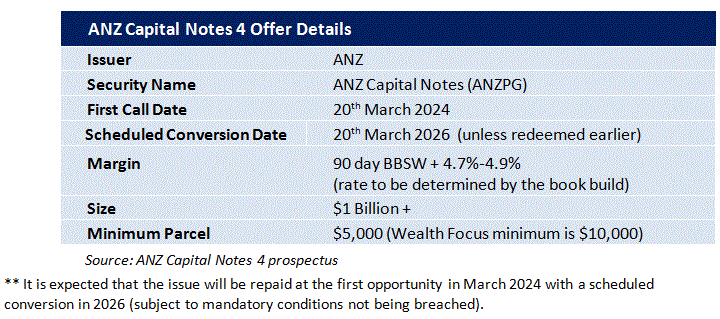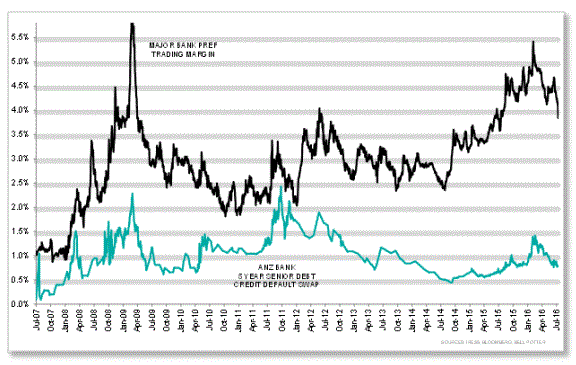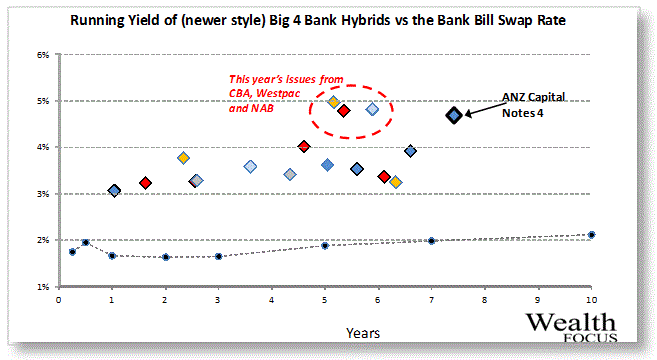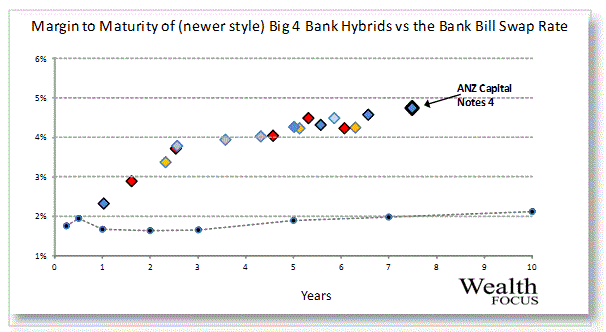ANZ has just announced the launch of a new income offer: ANZ Capital Notes 4. The first round of access is through a broker firm allocation, prior to shareholder and general offer and listing in September.
The Notes will pay a quarterly coupon of 4.7%-4.9% (margin determined by the book build) over the 90 day bank bill swap rate (BBSW), which was 1.76% as of 19th August. The initial indicative rate will be 6.46%-6.66%pa with the rate to be set on the date of issue. The Notes are expected to redeem on the 20th March 2024** and will be tradable on the ASX under code ANZPG.

Hybrids
We have covered the features of fixed income hybrids on numerous occasions over the previous 2 years. Investors who are looking for a basic understanding of hybrids and differentiating products should watch our online video An Introduction to Fixed Income.
Our analysis
In line with our view that hybrids offered exceptional value, the hybrid market has rallied strongly since we last wrote about NAB Capital Notes 2 earlier this year with spreads (Yield to Maturity) contracting by 0.5%pa.
As previously highlighted, current margins are in line with those seen during the GFC. This year’s hybrids have been issued at significantly wider spreads than prior years and are anticipated to be more attractive to retail investors.
The closest comparables to ANZPG are this year’s new issues, CBA Perls 8 (CBAPE), Westpac Capital Notes 4 (WBCPG), and NAB Capital Notes 2 (NABPD) issued at margins of 5.2%, 4.9% and 4.95% respectively.


We note that in times of market stress, hybrids offering higher running yields tend to avoid much of the sell off that lower yielding comparables experience, adding to the attraction of the increased yield.
Margin to Maturity in the secondary market
As hybrids are redeemed at face value, it is the Margin to Maturity which is an accurate measure for total return over the BBSW.
Looking at the secondary market, longer dated issues are now trading around 4.2%-4.5% over the BBSW (1.76%). Reflecting the longer term, ANZPG’s 4.7% margin sits in line with its peers the additional attraction of a higher running yield.

Non-viability Clause, Capital Trigger Event and Inability Event
Investors who are familiar with the new style hybrids we have seen over the last couple of years will be very aware of these clauses.
It is useful to understand that these clauses are as a result of APRA requiring further reassurance that in another GFC event, if required, hybrids would convert to ordinary equity, thereby reducing the bank’s debt costs and protecting deposit holders.
Now that banks have to hold a higher level of capital and a better quality loan book, it seems unlikely that any of these conditions would be breached, however, investors would do well to consider the increased disclosure and warnings within each prospectus over the last couple of years.
For those unfamiliar with the conditions, new hybrids now contain non-viability and capital trigger clauses that should the bank’s Tier 1 Capital Ratio fall below 5.125%, or APRA views the bank as non-viable without an injection of capital, the hybrids would automatically convert to ordinary shares.
We have also seen a gradual introduction of an Inability Event Clause added which states that in the event that the issuer is unable to issue further ordinary shares, ie the company has ceased trading, a Capital Trigger Event or Non-Viability Event, hybrid note holders lose their investment.
This is extremely unlikely however investors would do well to remember the increase in yield offered carries additional risk.
Our View on ANZ Capital Notes 4
We maintain our concerns over the non-viability clauses within the new style of hybrids but investors looking to switch equity allocation into an asset class with reduced capital risk would do well to consider these newer style hybrids. We do not consider hybrids a suitable alternative for fixed income/cash as it behaves differently during periods of financial market distress.
Since our last review of NAB Capital Notes 2 in May, hybrid spreads have contracted and ANZ Capital Notes 4 looks well priced. The Notes look to be priced in line with other Big 4 peers but offer a higher running yield than most of the other comparables.
Our view is ANZ would have likely been able to get away with a smaller spread, however, the $2 Billion of ANZPA that needs to be refinanced, has likely led to a wider margin than they would have otherwise been offered.
We have long held the view that the Big 4 are likely to face difficult times, increased capital requirements puts pressure on profitability and strengthens the security for hybrid holders.
It is our view that the anticipated cut in interest rates and a lack of new issues over the coming months will lead to a continued rally in hybrids. Although it is our view ANZ Capital Notes 4 is priced in line with the market, we expect the higher running yield to prove attractive and command a higher premium to investors.
Contact us if you would like an allocation to ANZ Capital Notes 4 or have an existing investment in ANZ CPS II (ANZPA) you would like to roll into the new issue.
Key features
- Indicative floating yield of 6.46%-6.66%pa – based on current 90 BBSW of 1.76% and book build margin range of 4.7%-4.9%.
- Option to redeem at year 7.5 with scheduled conversion at year 9.5 – ANZ has the option to convert in December 2024 or on any subsequent dividend payment date.
- Ordinary dividend restrictions – applies on the non-payment of ANZPG dividends
- Automatic conversion under the Capital Trigger Event and Non-Viability
Redemption highly likely in 7.5 years – although ANZPG has a 9.5 year maturity, it is expected ANZ will redeem/convert at the first call date in March 2024. Major incentives for redemption/conversion include the potential for reputational damage, leading to an increased cost of funding on future debt issues.
Note: ANZ Capital Notes 4 will be listed on the ASX and as such the price of the Note’s will be subject to market movements. Investors selling on market may receive a price lower (or higher) than the issue price.
Investors looking for an allocation can contact us on 1300 559 869
We encourage you to view our online presentation An Introduction to Fixed Income

Comment: